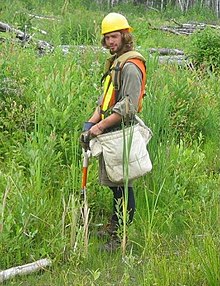
Back زرع الأشجار Arabic Šumska kultura BS Plantar árboles Spanish Metsa istutamine Estonian کاشت درخت Persian נטיעה HE वृक्षारोपण Hindi वृक्षारोपण Marathi ගස් සිටුවීම Singhalese Trädplantage Swedish



Tree planting is the process of transplanting tree seedlings, generally for forestry, land reclamation, or landscaping purposes. It differs from the transplantation of larger trees in arboriculture and from the lower-cost but slower and less reliable distribution of tree seeds. Trees contribute to their environment over long periods of time by providing oxygen, improving air quality, climate amelioration, conserving water, preserving soil, and supporting wildlife. During the process of photosynthesis, trees take in carbon dioxide and produce the oxygen we breathe.
In silviculture, the activity is known as "reforestation", or "afforestation," depending on whether the area being planted has recently been forested or not. It involves planting seedlings over an area of land where the forest has been harvested or damaged by fire, disease, or human activity. Tree planting is carried out in many different parts of the world, and strategies may differ widely across nations and regions and among individual reforestation companies. Tree planting is grounded in forest science and, if performed properly, can result in the successful regeneration of a deforested area. Reforestation is the commercial logging industry's answer to the large-scale destruction of old-growth forests, but a planted forest rarely replicates the biodiversity and complexity of a natural forest.[citation needed]
Because trees remove carbon dioxide from the air as they grow, tree planting can be used to help limit climate change. Desert greening projects are also motivated by improved biodiversity and reclamation of natural water systems, as well as improved economic and social welfare due to an increased number of jobs in farming and forestry.
© MMXXIII Rich X Search. We shall prevail. All rights reserved. Rich X Search